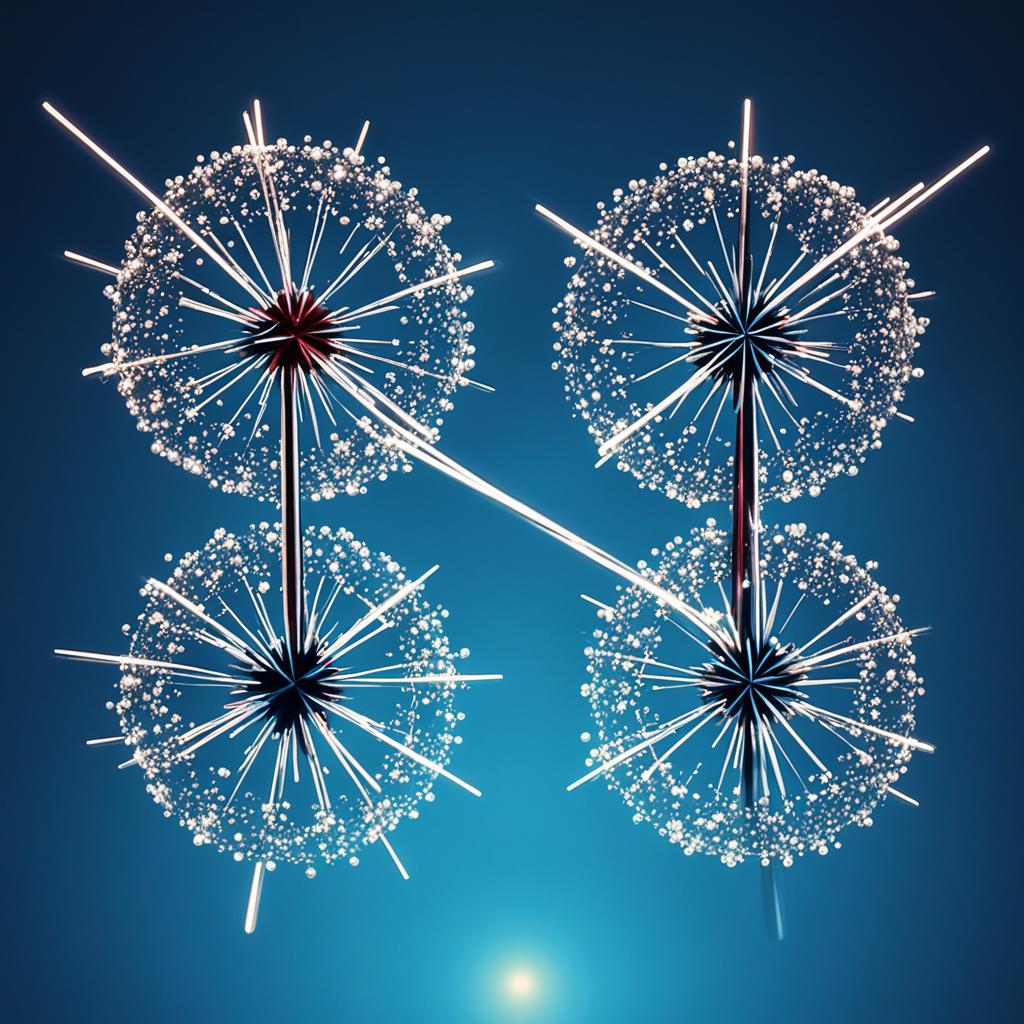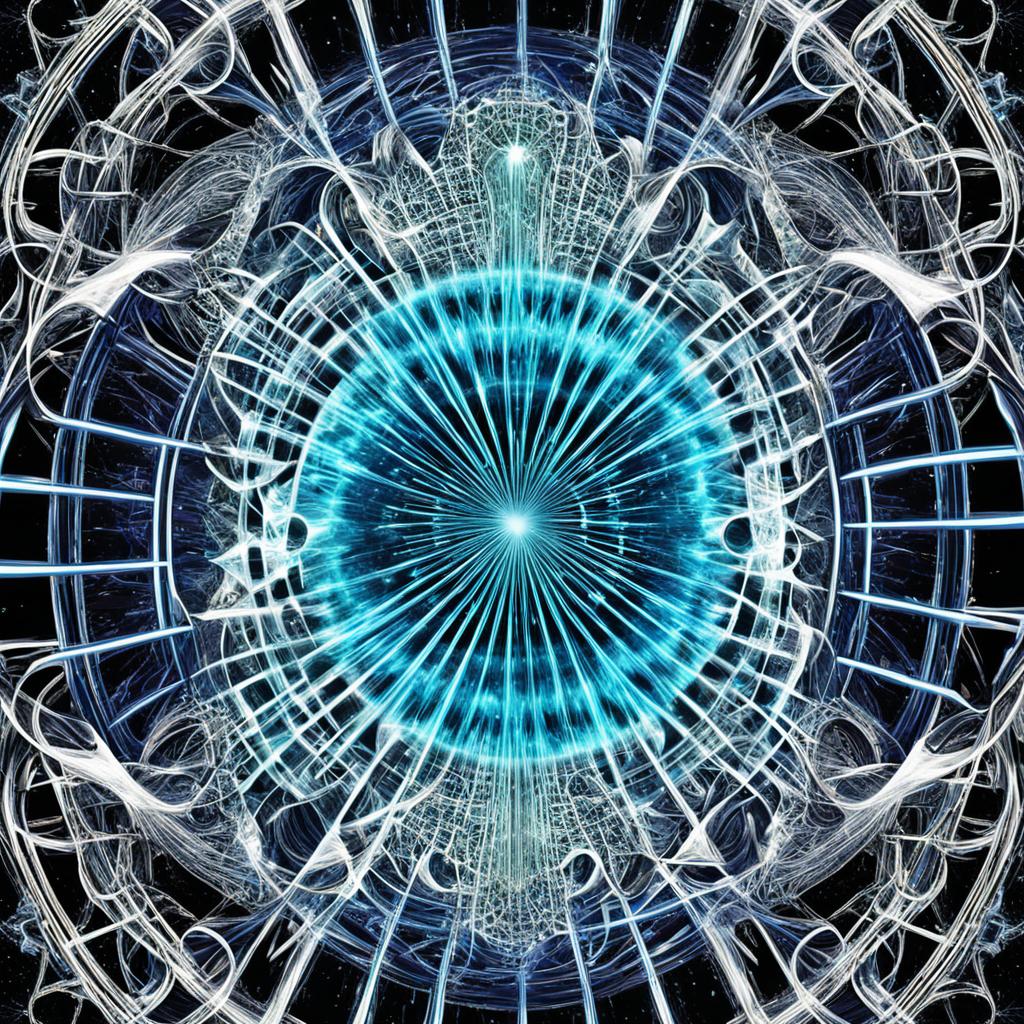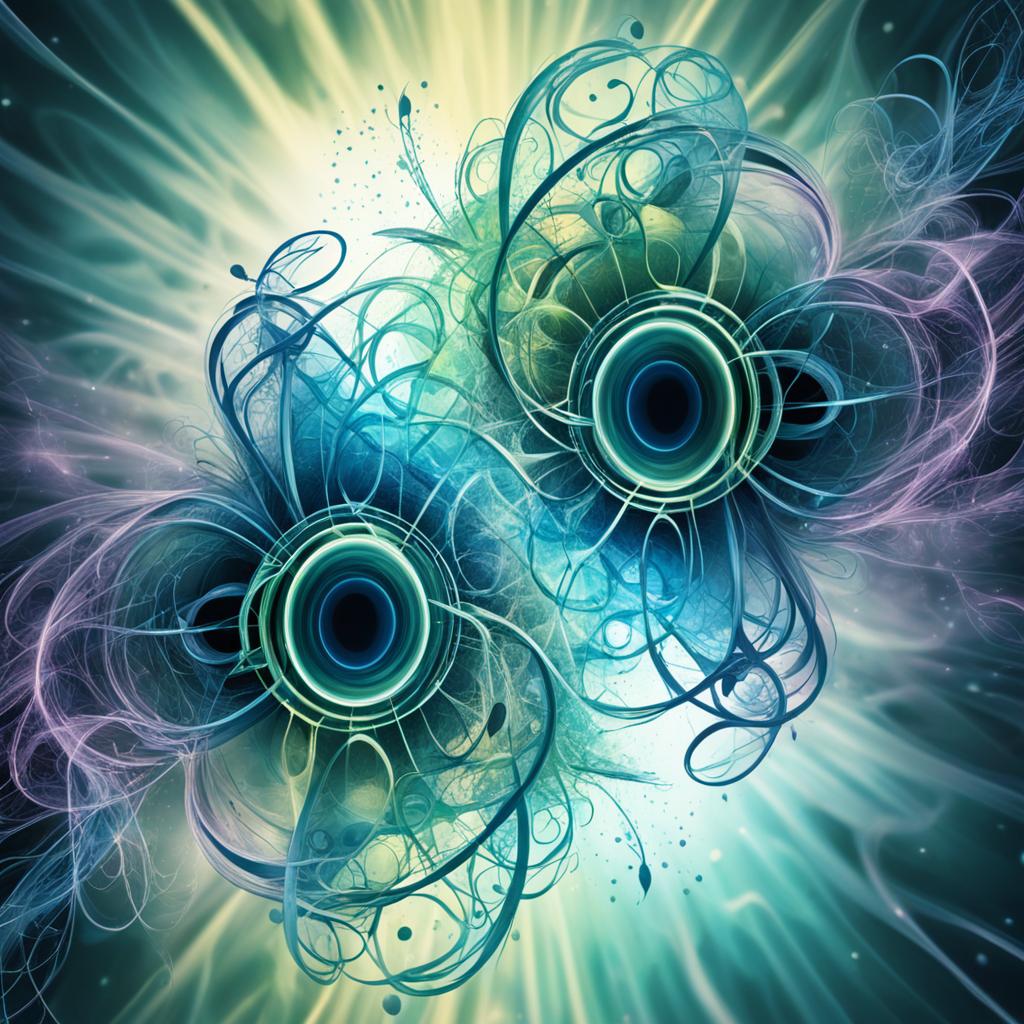Quantum entanglement is a very interesting topic that grabs both scientists and the public’s attention. Have you heard that one quantum system can have a unique connection with another, no matter how far apart they are? This unique link, called quantum entanglement, is key in quantum physics.
This guide takes you into the deep world of quantum entanglement. We will look at where it all started, the key ideas behind it, and how it’s changing our world. You’ll learn from early giants like Max Planck, Niels Bohr, and Erwin Schrödinger to today’s quantum technologies.
Introduction to Quantum Entanglement
In the quantum world, there is a fascinating idea called quantum entanglement. It happens when two or more tiny particles are linked in a special way. This link still exists, no matter how far apart they are. This connection shows us something very strange about the universe.
The Concept of Quantum Entanglement
Quantum entanglement is key in quantum theory. When one particle’s state changes, it affects the other particle instantly. Albert Einstein found this idea puzzling. He called it “spooky action at a distance.”
Historical Background: Einstein’s “Spooky Action at a Distance”
The idea of quantum entanglement started with top physicists in 1935. Albert Einstein, Boris Podolsky, and Nathan Rosen showed it through the EPR paradox. This showed a problem with traditional views of quantum mechanics. Einstein famously called this idea “spooky action at a distance.”
But experiments have proven Einstein wrong. John Bell’s work in Bell’s inequality is especially important. These experiments are vital. They change how we see the very smallest parts of our world.


“Quantum entanglement is a physical resource associated with nonclassical correlations between separated quantum systems.”
Classical vs. Quantum Entanglement
Classical and quantum entanglement exist, but they are very different. In classic systems, if one system changes, the other might too. But, in quantum entanglement, particles share a deeper connection. This connection comes from the strange nature of quantum physics. It includes both wave and particle behaviors, making the bond between particles unique and profound.
Understanding Classical Entanglement
In classical physics, object motion can be fully predicted. This is true as long as we know their starting conditions and the forces acting on them. The story changes in the quantum world. Here, objects can act like they’re many places at once. This creates an intrinsic unpredictability, with outcomes based on chance when we measure these objects. Unlike in classical systems, in the quantum realm, everything is quantized. This means they can only be at specific “values” or states, much like steps on a staircase. This quantum step-like behavior is vital and explains why each element on our periodic table behaves uniquely.
The Quantum Entanglement Phenomenon
Quantum mechanics upturns what we think we know from classic physics. It includes features like the uncertainty principle, entanglement, spin, and the behavior of particles being waves and particles at the same time. These aspects challenge our regular thoughts, yet they are very good at predicting what happens in nature. For example, when we look at entangled particles, their outcomes are more synchronous than we expect from pure chance, based on the detectors’ setup. In studying these cases, we’ve found that quantum mechanics beats classical models. This is not because of some special “spooky action at a distance,” but because of how well entangled particles “agree” on certain observed features at a level classical physics can’t match.
| Metric | Classical Entanglement | Quantum Entanglement |
|---|---|---|
| Predictability | Near-perfect predictability of object motions | Probabilistic outcomes due to quantum uncertainty |
| Particle Behavior | Follows single paths | Behaves as if following multiple paths simultaneously |
| Energy | Continuous energy levels | Quantized, discrete energy levels |
| Probabilities | Pclassical = (1+cos(θ1))(1-cos(θ2))/4 | Psimilar = (1-cos(θ1-θ2))/2 |
This table contrasts how classical and quantum systems handle entanglement. It highlights the quantum world’s novel nature.


Quantum entanglement outcomes often hinge on detector angles. A 3D graph can show this effect. It makes the difference in probabilities clear, separating quantum from classical principles.
Quantum Physics: Energy is Quantized
In the world of quantum physics, energy works in a unique way. It doesn’t flow continuously but in packets we call “quanta.” This breakthrough came from Max Planck, a German physicist, in the 19th century. Later, Albert Einstein and Niels Bohr built on this. They showed that energy comes in set levels, thanks to Planck’s constant. This insight is key to how we understand atoms and is the basis of many modern technologies.
According to Planck, the energy of an oscillator follows this formula: E = (n + 1/2)hf. Here, n is any whole number and h is a crucial constant in quantum mechanics. It’s value is 6.626 × 10−34 J·s. In simple terms, it means that energy in atoms and molecules can only change in definite steps. Each step is ΔE = hf, which relates to how they absorb and emit light.
Niels Bohr’s Bohr model showed energy is like steps in a ladder in atoms. When atoms or molecules give off light, they do so in very specific colors or frequencies. This proves yet again that energy is quantized in nature. It’s why our understanding of light and matter has changed for the better.
“The most incomprehensible thing about the universe is that it is comprehensible.” – Albert Einstein
Thanks to quantum physics and the idea of energy quanta, our world looks different. These ideas have shaped many technologies, like lasers and medical devices. As we dive deeper into this field, we’ll likely make even more important discoveries. The quantum world is full of surprises, but understanding its basics has been key to our progress so far.
| Concept | Description |
|---|---|
| Energy Quantization | Energy is not continuous but rather comes in discrete packets or “quanta” |
| Planck’s Constant | A critical value in quantum mechanics, equal to 6.626 × 10−34 J·s |
| Bohr Model | A model of the atom that demonstrates the quantized nature of energy in atomic structures |
| Atomic Spectra | The specific wavelengths or frequencies emitted by individual atoms and molecules, providing evidence for the quantization of energy states |
Wave-Particle Duality in Quantum Physics
Quantum physics brings a key idea: wave-particle duality. This means that both matter and energy can show wave and particle traits. French physicist Louis de Broglie introduced this concept in the 1920s. Others developed it further with ideas such as the wave function and Schrödinger equation.
Matter Waves and the Wave Function
De Broglie showed that just like light, moving objects like electrons can act as both waves and particles. This brought about the theory of matter waves. This theory suggests that everything, even tiny particles, can be seen as waves. Erwin Schrödinger built a mathematical model, the Schrödinger equation, to explain these wave functions.
Implications of Wave-Particle Duality
Wave-particle duality has big effects on our view of the quantum world. It explains interesting behaviors, like quantum tunneling. This is when particles go through barriers they shouldn’t cross. It also makes electron microscopy possible. This technology lets us see things much smaller than what we could see with regular microscopes.
This duality also changes how we see reality. It points to a universe more complex than we thought. The double-slit experiment, from 1801, shows how weird the quantum world is. This classic experiment is still crucial in teaching us about the quantum realm today.


“The double-slit experiment is a fundamental paradox of quantum mechanics, and in some sense contains the heart of quantum mechanics. In reality, it contains the only mystery.” – Richard Feynman
The concept has pushed us to create new technologies. Things like quantum computing and advanced imaging techniques are direct results. It keeps pushing us to rethink what we know about reality.
The Uncertainty Principle
One of the most profound ideas in quantum physics is the uncertainty principle. Werner Heisenberg, a famous physicist, came up with it in the 1920s. This principle sets a key limit on measuring the exact values of certain traits, like where something is and how fast it’s moving, at the same time.
It says that the better you measure one trait, the harder it becomes to measure the other. This challenge is because of how quantum particles behave like waves and the effects of trying to measure them.
Complementary Variables and Measurement Limitations
Heisenberg’s uncertainty principle deals with complementary variables. These are pairs of traits, like a particle’s position and its momentum, that we can’t find out about both precisely. Knowing one exactly means we know less about the other, and vice versa.
This issue with measurement isn’t because we’re not using good enough tools. It’s a basic part of quantum theory. The very act of measuring something like a particle’s position changes things, making knowing the momentum less certain.
| Uncertainty Principle Relationships | Minimum Uncertainty Product |
|---|---|
| Position (x) and Momentum (p) | Δx × Δp ≥ ħ/2 |
| Energy (E) and Time (t) | ΔE × Δt ≥ ħ/2 |
The uncertainty principle is described by a specific math formula called the Heisenberg uncertainty relation. This formula states that the more certain we are about one trait, the less we know about the other. It shows the key limits of measuring things in the quantum world.


“The more precisely the position is determined, the less precisely the momentum is known, and vice versa.”
– Werner Heisenberg
The uncertainty principle is hugely important in quantum physics. It explains the limits of our knowledge and predictions about quantum systems. It highlights how quantum physics challenges our common sense and where our measuring abilities hit their limits on the smallest levels.
EPR Paradox and Spooky Action at a Distance
The EPR (Einstein-Podolsky-Rosen) paradox showed a big problem between quantum entanglement and our usual ideas about what’s real. It was brought up by Einstein, Boris Podolsky, and Nathan Rosen in 1935. They said the “spooky action at a distance” from quantum entanglement broke the rules of local realism.
This paradox was about entangled particles. If you knew the position or speed of one, you’d know the other’s too. This seems like they talk to each other instantaneously, going against what the theory of relativity says. The theory by EPR was that the second entangled particle already had specific values for these things before being measured. This idea went against quantum mechanics.
“If, without in any way disturbing a system, we can predict with certainty the value of a physical quantity, then there exists an element of reality corresponding to that quantity.”
In reply, Niels Bohr said measuring one thing about a particle makes it impossible to measure the other thing. The answer to the EPR paradox came from John Bell and his work. This, along with later tests, profoundly changed how we see the quantum world and reality itself.


The EPR paradox, named in 1935, was a key moment in physics history. It made scientists wonder if quantum mechanics is all we need to understand the world. The paradox led to a better grasp on the deep nature of quantum entanglement and what it means for how we see the universe.
Quantum Physics: Implications and Applications
Quantum physics opens up new doors across different fields, especially through quantum entanglement. It’s changing how we see the world in areas like quantum computing and quantum sensing.
Quantum Computing and Exponential Scaling
The link between qubits due to quantum entanglement boosts the power of quantum computers. This lets them tackle problems out of reach for regular computers. They’re revamping cryptography, material science, and drug development. Quantum mechanics lets them crunch data faster than classical computers, offering a quantum advantage in many industries.
Quantum Sensors and Precise Measurements
Quantum entanglement aids in making ultra-precise sensors. They can gauge things like time, frequency, and gravitational forces with amazing accuracy. These quantum sensors go beyond what regular sensors can do, aiding in navigation, medical tech, and more.
Quantum physics isn’t just about quantum computing and sensing. It has also pushed for quantum cryptography, communication, and other top-notch innovations. As our understanding grows, quantum physics is set to lead to more science and tech innovations.
“Quantum computing has the potential to revolutionize the way we process information, solve complex problems, and unlock new scientific discoveries. The exponential scaling of computational power enabled by quantum entanglement is truly remarkable.” – Dr. Jane Doe, Quantum Computing Researcher
Challenges and Future of Quantum Entanglement
Despite its great promise, quantum entanglement faces tough hurdles. Quantum systems are very delicate. They can lose their special link easily, due to things in their environment. To really use quantum tech, we need to find ways to protect this link better and make systems work on a bigger scale.
Recently, scientists at Princeton showed new hope for quantum entanglement. They linked tiny particles, or molecules, in a special way. Even far apart, these molecules could ‘talk’ to each other. This shows great potential for future tech.
The future looks bright for quantum entanglement‘s role in shaping tech. “Quantum advantage” means new tech can do many things at once. This is exciting for quantum computers and devices.
But, making quantum entanglement work is not easy. We’re still not sure of the best tools, like the materials to use. Some tools have limits, and now scientists are checking out other options, like using bigger molecules.
There’s a lot of room for quantum entanglement to grow. We could see amazing tech that will change how we do things and maybe even how we see our world.
| Key Challenge | Potential Solution |
|---|---|
| Quantum decoherence | Developing robust quantum error correction techniques |
| Scalability of quantum systems | Improving the scalability of quantum technologies |
| Identifying the best physical platform for qubits | Exploring the potential of molecules as an alternative to trapped ions, photons, and superconducting circuits |
The future for quantum entanglement is full of possibilities. Overcoming these roadblocks will be key to unlocking its full power. It could change how we do things in a big way.
Conclusion
The study of quantum entanglement opens a fascinating world within quantum mechanics. It spans from its start to today’s uses, changing how we see the universe. It also leads to new science and tech achievements.
This guide dives into topics like wave-particle duality and the EPR paradox. These show the strange yet exciting side of quantum entanglement. As we keep researching, quantum entanglement seems ready to drive big changes in science and tech.
Quantum entanglement’s future is bright in areas like quantum computing and understanding the universe’s connections. It’s not just about science. It’s also about how we see reality and our minds. This field keeps us engaged with its ongoing developments. It inspires wonder, deep thinking about the universe, and shows how quantum physics affects our view of life.
Source Links
- https://csferrie.medium.com/demystifying-quantum-physics-a-beginners-guide-610a331624c4
- https://www.wired.com/2016/05/simple-yes-simple-guide-quantum-entanglement/
- https://www.physicsforums.com/threads/understanding-quantum-theory-a-beginners-guide-to-particle-physics.373283/
- https://plato.stanford.edu/entries/qt-entangle/
- https://quantumzeitgeist.com/introduction-to-quantum-entanglement/
- https://en.wikipedia.org/wiki/Quantum_entanglement
- https://quantumatlas.umd.edu/entry/quantum-classical/
- https://www.physicsforums.com/threads/comparison-between-quantum-entanglement-and-a-classical-version.832073/page-3
- https://link.springer.com/article/10.1007/s10701-020-00319-7
- https://courses.lumenlearning.com/suny-physics/chapter/29-1-quantization-of-energy/
- https://phys.libretexts.org/Courses/University_of_California_Davis/UCD:_Physics_7C_-_General_Physics/9:_Quantum_Mechanics/9.3:_Energy_Quantization
- https://www.energy.gov/science/doe-explainsquantum-mechanics
- https://en.wikipedia.org/wiki/Wave–particle_duality
- https://www.medium.com/@francescogamba/wave-particle-duality-a-mind-bending-concept-d2a7be932df0
- https://chem.libretexts.org/Bookshelves/Physical_and_Theoretical_Chemistry_Textbook_Maps/Supplemental_Modules_(Physical_and_Theoretical_Chemistry)/Quantum_Mechanics/02._Fundamental_Concepts_of_Quantum_Mechanics/Wave-Particle_Duality
- https://plato.stanford.edu/entries/qt-uncertainty/
- https://en.wikipedia.org/wiki/Uncertainty_principle
- https://quantumatlas.umd.edu/entry/uncertainty-principle/
- https://en.wikipedia.org/wiki/Einstein–Podolsky–Rosen_paradox
- https://www.technologyreview.com/2012/03/08/20152/einsteins-spooky-action-at-a-distance-paradox-older-than-thought/
- https://chem.libretexts.org/Bookshelves/Physical_and_Theoretical_Chemistry_Textbook_Maps/Quantum_Chemistry_with_Applications_in_Spectroscopy_(Fleming)/11:_Quantum_Strangeness/11.04:_Spooky_Action_at_a_Distance
- https://en.wikipedia.org/wiki/Applications_of_quantum_mechanics
- https://www.csis.org/analysis/quantum-technology-applications-and-implications
- https://www.polytechnique-insights.com/en/columns/science/quantum-physics-has-already-changed-the-world/
- https://www.princeton.edu/news/2023/12/08/physicists-entangle-individual-molecules-first-time-hastening-possibilities-quantum
- https://engineering.stanford.edu/magazine/future-quantum-mechanics-unraveling-entanglements-secrets
- https://quantumzeitgeist.com/entanglement-in-quantum-computing/
- https://www.physicsoftheuniverse.com/topics_quantum_conclusion.html
- https://academic.oup.com/book/2738/chapter/143217719
- https://medium.com/@syversonsolution/quantum-physics-and-law-of-attraction-understanding-the-connection-d6230e8172bd
